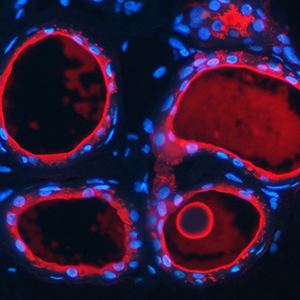Differential antigen expression between human apocrine sweat glands and eccrine sweat glands

Submitted: 18 September 2022
Accepted: 29 November 2022
Published: 22 December 2022
Accepted: 29 November 2022
Abstract Views: 911
PDF: 592
HTML: 50
HTML: 50
Publisher's note
All claims expressed in this article are solely those of the authors and do not necessarily represent those of their affiliated organizations, or those of the publisher, the editors and the reviewers. Any product that may be evaluated in this article or claim that may be made by its manufacturer is not guaranteed or endorsed by the publisher.
All claims expressed in this article are solely those of the authors and do not necessarily represent those of their affiliated organizations, or those of the publisher, the editors and the reviewers. Any product that may be evaluated in this article or claim that may be made by its manufacturer is not guaranteed or endorsed by the publisher.
Similar Articles
- E Brunelli, I Perrotta, A Bonacci, S Tripepi, Differential expression of aquaporin 3 in Triturus italicus from larval to adult epidermal conversion , European Journal of Histochemistry: Vol. 51 No. 1 (2007)
- CarloAlberto Redi, Mouse cell culture - Methods and protocols , European Journal of Histochemistry: Vol. 54 No. 4 (2010)
- Z Kalnina, K Silina, R Bruvere, N Gabruseva, A Stengrevics, S Barnikol-Watanabe, M Leja, A Line, Molecular characterisation and expression analysis of SEREX-defined antigen NUCB2 in gastric epithelium, gastritis and gastric cancer , European Journal of Histochemistry: Vol. 53 No. 1 (2009)
- L. Pilloni, C. Manieli, G. Senes, D. Ribuffo, G. Faa, Merkel cell carcinoma with an unusual immunohistochemical profile , European Journal of Histochemistry: Vol. 53 No. 4 (2009)
- A Casasco, M Casasco, A Icaro Cornaglia, N Zerbinati, G Mazzini, A Calligaro, Cell kinetics in a model of artificial skin. An immunohistochemical and flow cytometric analysis , European Journal of Histochemistry: Vol. 45 No. 2 (2001)
- A. Amaroli, M.G. Chessa, Detection and characterisation of NAD(P)H-diaphorase activity in Dictyostelium discoideum cells (Protozoa) , European Journal of Histochemistry: Vol. 56 No. 4 (2012)
- Li Niu, Xiaoying Chu, Yaofei Jiang, Wei Zeng, HPV infection upregulates the expression of ZNT-1 in condyloma acuminatum , European Journal of Histochemistry: Vol. 65 No. 2 (2021)
- Qichao Yin, Hua Xiong, Chemotherapy-induced nephrotoxicity was improved by crocin in mouse model , European Journal of Histochemistry: Vol. 66 No. 4 (2022)
- J Sassone, A Ciammola, C Tiloca, M Glionna, G Meola, E Mancinelli, V Silani, Apoptosis induced by proteasome inhibition in human myoblast cultures , European Journal of Histochemistry: Vol. 50 No. 2 (2006)
- Liyun Guan, Ying Wang, Jianxin Cheng, Jun Zhang, Shan Kang, Expression and clinical significance of HER2/neu, aromatase P450 and adhesion molecule CD24 in endometrial cancer , European Journal of Histochemistry: Vol. 67 No. 3 (2023)
<< < 51 52 53 54 55 56 57 58 59 60 > >>
You may also start an advanced similarity search for this article.

 https://doi.org/10.4081/ejh.2023.3559
https://doi.org/10.4081/ejh.2023.3559











